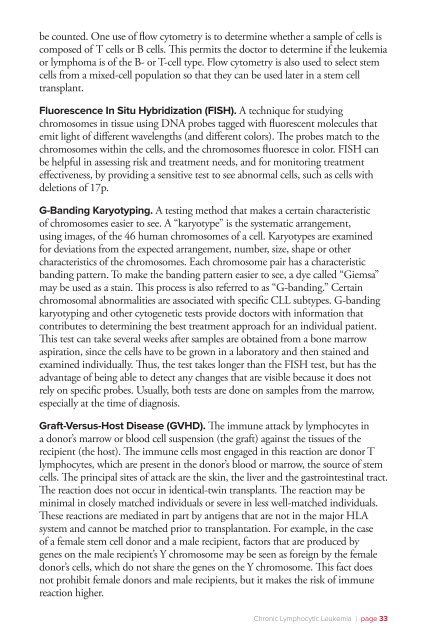Chronic Lymphocytic Leukemia - The Leukemia & Lymphoma Society
Chronic Lymphocytic Leukemia - The Leukemia & Lymphoma Society
Chronic Lymphocytic Leukemia - The Leukemia & Lymphoma Society
Create successful ePaper yourself
Turn your PDF publications into a flip-book with our unique Google optimized e-Paper software.
e counted. One use of flow cytometry is to determine whether a sample of cells is<br />
composed of T cells or B cells. This permits the doctor to determine if the leukemia<br />
or lymphoma is of the B- or T-cell type. Flow cytometry is also used to select stem<br />
cells from a mixed-cell population so that they can be used later in a stem cell<br />
transplant.<br />
Fluorescence In Situ Hybridization (FISH). A technique for studying<br />
chromosomes in tissue using DNA probes tagged with fluorescent molecules that<br />
emit light of different wavelengths (and different colors). <strong>The</strong> probes match to the<br />
chromosomes within the cells, and the chromosomes fluoresce in color. FISH can<br />
be helpful in assessing risk and treatment needs, and for monitoring treatment<br />
effectiveness, by providing a sensitive test to see abnormal cells, such as cells with<br />
deletions of 17p.<br />
G-Banding Karyotyping. A testing method that makes a certain characteristic<br />
of chromosomes easier to see. A “karyotype” is the systematic arrangement,<br />
using images, of the 46 human chromosomes of a cell. Karyotypes are examined<br />
for deviations from the expected arrangement, number, size, shape or other<br />
characteristics of the chromosomes. Each chromosome pair has a characteristic<br />
banding pattern. To make the banding pattern easier to see, a dye called “Giemsa”<br />
may be used as a stain. This process is also referred to as “G-banding.” Certain<br />
chromosomal abnormalities are associated with specific CLL subtypes. G-banding<br />
karyotyping and other cytogenetic tests provide doctors with information that<br />
contributes to determining the best treatment approach for an individual patient.<br />
This test can take several weeks after samples are obtained from a bone marrow<br />
aspiration, since the cells have to be grown in a laboratory and then stained and<br />
examined individually. Thus, the test takes longer than the FISH test, but has the<br />
advantage of being able to detect any changes that are visible because it does not<br />
rely on specific probes. Usually, both tests are done on samples from the marrow,<br />
especially at the time of diagnosis.<br />
Graft-Versus-Host Disease (GVHD). <strong>The</strong> immune attack by lymphocytes in<br />
a donor’s marrow or blood cell suspension (the graft) against the tissues of the<br />
recipient (the host). <strong>The</strong> immune cells most engaged in this reaction are donor T<br />
lymphocytes, which are present in the donor’s blood or marrow, the source of stem<br />
cells. <strong>The</strong> principal sites of attack are the skin, the liver and the gastrointestinal tract.<br />
<strong>The</strong> reaction does not occur in identical-twin transplants. <strong>The</strong> reaction may be<br />
minimal in closely matched individuals or severe in less well-matched individuals.<br />
<strong>The</strong>se reactions are mediated in part by antigens that are not in the major HLA<br />
system and cannot be matched prior to transplantation. For example, in the case<br />
of a female stem cell donor and a male recipient, factors that are produced by<br />
genes on the male recipient’s Y chromosome may be seen as foreign by the female<br />
donor’s cells, which do not share the genes on the Y chromosome. This fact does<br />
not prohibit female donors and male recipients, but it makes the risk of immune<br />
reaction higher.<br />
<strong>Chronic</strong> <strong>Lymphocytic</strong> <strong>Leukemia</strong> I page 33

















